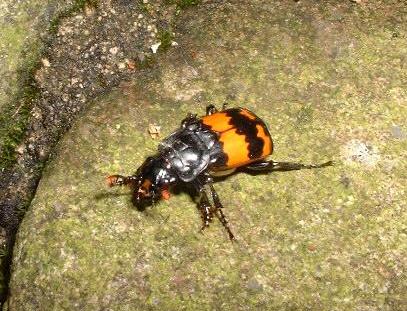The Sexton or Burying Beetle got its name from the fact that the adults bury the corpses of small mammals and birds to feed their larvae. The genera name comes from a misspelling of the Greek "necro" which is the stem of many words relating to death. The male and female take part in the burial by excavating the soil below the body and the animal sinks into the ground. They also have a rather unique parental caring role among invertebrates by staying with the larvae to protect, and help them to feed.

Nicrophorus investigator is about 21mm long: note the lack of hairs around the thorax distinguishing it from the more common N. vespilloides
There are six species of Sexton Beetle in the UK; five of which have the black and orange wing cases. They fly well and are said to be able to scent a dead body up to two miles away. When the the burial is complete - a process which can take up to 8 hours - the adults strip off the fur or feathers. As they do this they coat the carcass with secretions which slow the decay processes and prevent the odour from attracting other animals. The female then lays the eggs in the soil nearby where they hatch after a few days. The larvae are able to feed on their own but, to speed their development the parents digest the flesh and regurgitate the liquidised food. If there are too many larvae for the size of the carcass the parents may reduce the number to suit. Also if the carcass is large a number of adult pairs may co-operate in the burial and share it to raise their offspring together. The larval stage lasts for several days then they move off into the nearby soil where they pupate.